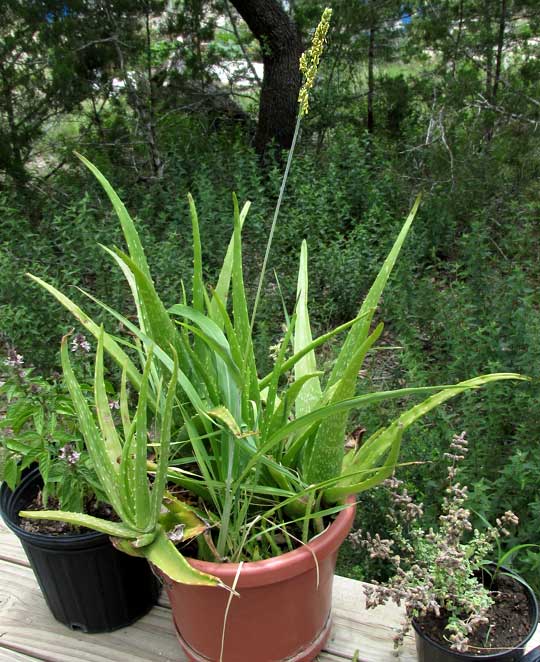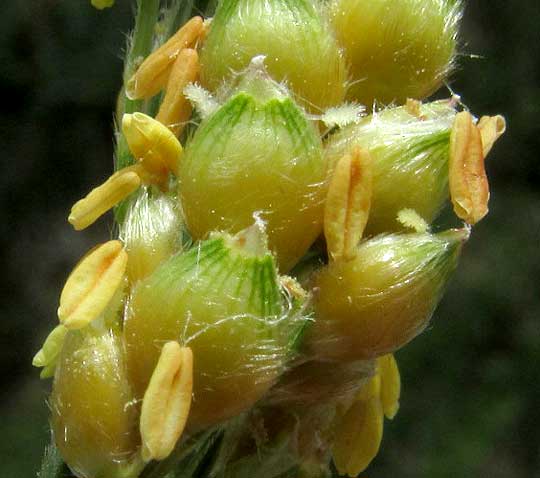Excerpts from Jim Conrad's
Naturalist Newsletter
from the August 3, 2014 Newsletter issued from the Frio Canyon Nature Education Center in the valley of the Dry Frio River in northern Uvalde County, southwestern Texas, on the southern border of the Edwards Plateau; elevation ~1750m (~5750 ft); N29.62°, W99.86°; USA
MILO
On the bench below the birdfeeder on Juniper House's deck I keep several pots of herbs, and a big pot of Aloe vera. I like having Aloe vera around not only so I'll have the succulent leaves handy so I can daub their gummy juice onto burns and other skin irritations, but also I make a pleasant tea from the gel inside the leaves. Well, a seed from the birdfeeder must have fallen into the Aloe vera's pot, for a grass grew up there and since it didn't look like a weed grass, I let it flower. You can see the grass in its pot below:

The grass's flowers where sexually active a couple of weeks ago when pollen was being released from pale yellow anthers dangling from threadlike filaments, as seen below in a picture of the flowering head:

In that picture notice that the individual spikelets are on short stems, or pedicels, which arise from branches off the main flowering stem, or rachis.
In other words, this flowering-head is a panicle-type inflorescence, something to keep in mind during the identification process. Below, you can see individual spikelets, some of their florets issuing fuzzy stigmas for collecting pollen, and other spikelets whose florets have dangling, banana-like anthers with open pores at their bottoms where pollen dribbles out:

Seeing the very plump spikelets held in a panicle, already I suspected the grass's identity this was, but just to be thorough in gathering information for IDing, I photographed the ligule, the obscure, wall-like growth at a grass blade's bottom where it meets the stem. Ligules look the same throughout a species, but vary drastically between genera and species, and sometimes don't exist at all. Below, you can see that this grass's ligules consist of a low, green, membranous wall topped with tiny, white hairs, or cilia:

This week, after two weeks of growth, the caryopsis-type grains, or fruits, have enlarged much, much more than "normal" grass grains might, becoming more or less spherical and actually swelling well beyond the scales, or glumes, lemma and pellea, that enclose the mature grains of normal florets. You can see this below:

Not only does that picture show us the oversized grains, but also now that the individual florets are pushed apart by their big grains impinging on one another, it can be see that next to every hairy spikelet producing a big grain there are smaller, slenderer, less hairy spikelets. The big, hairy ones are fertile spikelets while the smaller, less hairy ones either are male or completely sterile. You might also make out that the large, fertile ones don't have a stem beneath them, while the smaller, infertile ones do. This manner of having its inflorescence composed of pairs of spikelets, with one of the pair being large, fertile, stemless and the other smaller, infertile and short-stemmed, is an important feature of this grass.
So, this is SORGHUM BICOLOR, one of the world's most important domesticated plants, being the fifth-most consumed of all grasses, only being eaten less than corn (maize), rice, wheat and barley. Over the centuries humans have developed many cultivars from the species, and today these cultivars are thought of as clustering into four major groups:
1) Milo; large grains, drought resistant, forming many side-shoots
2) Kafir sorghum; thick stalks and big leaves, for forage and grain
3) Sweet sorghum; juicy stalks for animal fodder and sorghum syrup
4) Broomcorn sorghum; much branched, used for making brooms
Our Sorgum bicolor, because of its large grains, is of the Milo type -- sometimes referred to as grain sorghum. That sounds right because the bag my birdseed came in says it contains "White Millet, Milo, Wheat, Cracked Corn, Black Oil Sunflower." Millet grains are smaller -- "canary seeds."
Though many researchers have tried to figure out the horticultural history of Sorgum bicolor, its history is still not clear. It appears to be native to Africa, especially Ethiopia, but its domestication either could have begun there, or the wild grain could have been carried to India where it was domesticated, then returned to Africa, where it was further developed. It's believed that African slaves brought sorghum seeds with them to the US, and now the US is the top sorghum growing country in the world.
My guess is that during upcoming years Milo will become even more important in the US as a cereal crop, because as global warming brings less rain to traditional corn (maize)-growing states, those states will shift to Milo because it needs much less watering. Also, Corn is cross-pollinated, so that if rain fails during silking time, barren ears (no kernels) may develop. But Milo is self-pollinated and produces heads over a longer time, so several weeks of severe drought affect Milo much less. In long droughts, Milo may produce fewer and smaller heads, but at least they produce something, when corn may produce nothing.